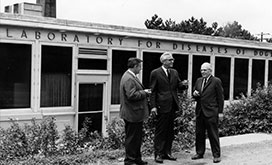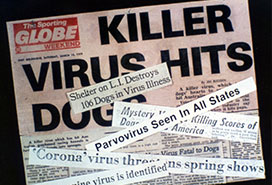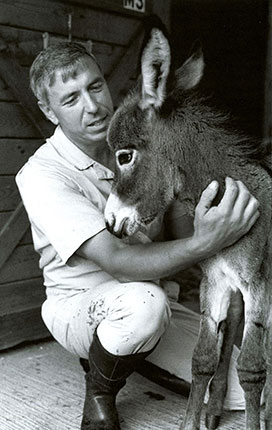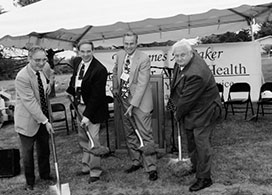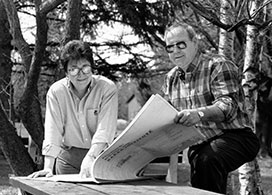The history of the Baker Institute for Animal Health
Former Leadership
Emeritus Faculty
*notes deceased
Max J. G. Appel
mja13@cornell.edu
George Lust
Douglas McGregor
History
The Baker Institute was born the Veterinary Virus Research Institute in September, 1950, at a time when the study of viruses received very little attention in veterinary schools. Under the energetic and visionary leadership of its founding director, Dr. James A. Baker, the Institute made major contributions to the control of diseases of livestock, especially diseases of cattle and pigs. Baker and his colleagues, however, earned their most enduring renown for their pioneering and prolific work in the field of canine diseases. Only two years after the Institute was founded, Baker announced the development of the first experimental vaccine against canine infectious hepatitis. This had been combined with the now-famous Snyder Hill strain of canine distemper virus isolated at the Institute, thus becoming the first dual-virus vaccine for animals.
The foundation that Dr. Baker laid so carefully for the study of infectious diseases was put to the test three years after his death in 1975. The sudden emergence of canine parvovirus (CPV) in 1978 presented the Institute with its most urgent challenge since the early days of distemper and hepatitis. Within three years, the work of Institute virologists Max Appel and L.E. Carmichael had culminated in the perfection of the modified live-virus vaccine that is still in use today. For many years, that discovery was Cornell's most valuable source of patent income.
Once the Institute had defined its infectious disease control program it also became possible to devote resources to other kinds of problems in animal health. At the urging of John M. Olin '13, a major founding benefactor and the first chairman of the Institute's Advisory Council, Baker in 1965 launched a new program to study canine hip dysplasia. He recruited physiological chemist George Lust in 1968 to head the program, which has grown under his direction to encompass molecular and biochemical studies of the genetics and pathogenesis of this condition. The biochemistry of osteoarthritis, the inevitable consequence of hip dysplasia, has also become an important focus of investigation at the Institute.
In the 1970's, immunology emerged as a separate discipline and an area of major interest in biomedical research. The Institute had always studied practical questions of immunology, such as response to vaccination, but the Institute's third decade saw a significant rise in basic research - and in funding from the National Institutes of Health. The transition was formalized with the recruitment of Douglas McGregor, a physician and immunologist from the Trudeau Institute, to lead the Institute into the post-Baker era. Robin Bell soon joined the faculty, followed in the early 1980's by Judy Appleton. Studies included fundamental questions of host-parasite interactions that have let to a better understanding of mechanisms of immunity that operate in the intestinal tract. Dr. Appleton transitioned to an administrative position in 2013; Dr. Bell retired in the spring of 2004.
Doug Antczak, the former director of the Baker Institute, was also recruited to study basic immunological questions. His interest in the major histocompatibilty complex, or MHC, of the horse has driven his research for over 20 years. His studies of equine pregnancy have served to bridge the Institute's historical programs in infectious diseases and immunology with the new studies in genetics, reproduction, and developmental biology that developed in the 1990's.
Colin Parrish, the former director of the Institute, distinguished himself as a graduate student in Professor Carmichael's laboratory during the parvovirus crisis and returned to the Institute in 1984 as a faculty member. His work has focused on the mechanisms that determine host range among closely related parvoviruses and, more recently, on the infection pathway taken by canine parvovirus once it penetrates the cell membrane.
In the last decade of the 20th century, the Institute undertook a major expansion into molecular genetics research. During 1992-1994, Greg Acland, Gus Aguirre, Jamie MacLeod, Vicki Meyers-Wallen, and Jharna Ray all joined the faculty. With their recruitment, the genetic causes of inherited diseases of the eye, skeletal system, and reproductive system came under intense study at the Institute.
Today, the Institute remains committed to its original purpose: to add to our understanding of animal diseases and to find the means to control their spread. In this, the scientists of the Baker Institute continue to achieve remarkable success.



